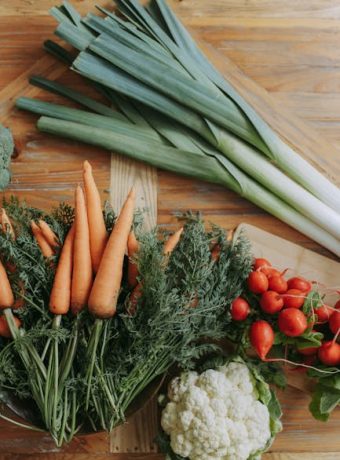Spring Vegetables: Best Picks for Stir-Fries
Spring is a time of renewal and freshness, and nothing exemplifies this better than the bounty of vibrant vegetables that come into season. As the chilly days of winter fade away, markets are filled with a variety of fresh produce that not only adds colors to your plate but also bursts with flavor. Among the most popular ways to enjoy these springtime veggies is in a delicious stir-fry. Stir-fries are quick to prepare, retain the nutrients of the vegetables, and are incredibly versatile.
In this blog post, we will explore the best spring vegetables for stir-fries, their nutritional benefits, and how you can incorporate them into your meals. Whether you are a seasoned chef or a home cook looking to spice up your culinary repertoire, these vegetables are sure to offer both taste and health benefits.
Why Choose Stir-Fries?
Stir-fries are a popular cooking method across the globe due to their ease, speed, and adaptability. Here are some reasons why you should consider making stir-fries a staple in your spring menu:
- Quick Cooking Time: Stir-fries typically take less than 30 minutes from prep to table, making them ideal for busy weeknights.
- Retained Nutrients: The quick cooking process helps retain the vegetables’ nutrients, ensuring you get the maximum health benefits.
- Flavorful: The combination of fresh vegetables, sauces, and spices results in a burst of flavors with every bite.
- Versatile: You can mix and match vegetables based on availability and personal preference, making endless combinations possible.
Top Spring Vegetables for Stir-Fries
As spring unfolds, various vegetables become available, each bringing unique flavors and textures. Here are some of the best spring vegetables to consider for your stir-fry:
1. Asparagus
Asparagus is one of the first vegetables to herald the arrival of spring. Its crisp texture and slightly earthy flavor make it an excellent addition to stir-fries. Asparagus is rich in vitamins A, C, E, and K, as well as folate and fiber.
Tip: Trim the woody ends and cut the spears into bite-sized pieces for even cooking. Toss them into the stir-fry towards the end to maintain their crispness.
2. Snap Peas
Snap peas are known for their sweet taste and crunchy texture. They are an excellent source of vitamins C and K, and they add a refreshing sweetness to stir-fries.
Tip: Remove the strings along the edges for a more pleasant eating experience. Snap peas cook quickly, so add them in the last few minutes of cooking.
3. Bok Choy
Bok choy, also known as Chinese cabbage, is a staple in many Asian cuisines. It has a mild flavor with a crunchy stem and tender leaves, making it perfect for stir-fries. It’s packed with vitamins A, C, and K, and is a great source of calcium and iron.
Tip: Separate the leaves and stems, adding the stems first to ensure even cooking.
4. Broccoli
Broccoli is a nutrient powerhouse, rich in vitamins C and K, fiber, and numerous antioxidants. Its slightly bitter taste mellows out when cooked, making it a versatile option for stir-fries.
Tip: Cut the florets into small, uniform pieces for faster cooking. Consider blanching them briefly before stir-frying for a vibrant color and tender texture.
5. Spinach
Spinach is a tender leafy green that wilts beautifully in stir-fries. It’s an excellent source of iron, calcium, vitamins A, C, and K. Its mild flavor allows it to blend well with other vegetables and sauces.
Tip: Add spinach towards the end of cooking. It wilts quickly, so there’s no need for prolonged cooking.
6. Carrots
Carrots add a pop of color and sweetness to any stir-fry. They are rich in beta-carotene, fiber, vitamin K1, and potassium.
Tip: Slice carrots thinly or julienne them for quicker cooking. You can also parboil them if you prefer a softer texture.
Essential Tips for Perfect Stir-Fries
Creating a perfect stir-fry is as much about technique as it is about ingredients. Here are some tips to ensure your stir-fry is a success every time:
- Preheat Your Pan: Ensure your wok or skillet is hot before adding oil. This helps to sear the vegetables quickly, preserving their texture and flavor.
- Use the Right Oil: Choose oils with a high smoke point, such as sesame or peanut oil, to prevent burning.
- Cut Evenly: Uniformly cut vegetables ensure even cooking. This is especially important for vegetables with varying cooking times.
- Don’t Overcrowd the Pan: Cook in batches if necessary. Overcrowding can lead to steaming instead of frying, which can make vegetables soggy.
- Season Wisely: Add sauces and seasonings towards the end of the cooking process to enhance flavors without overwhelming them.
Conclusion
Spring vegetables offer a wealth of flavors and nutrients that are perfect for creating delicious and healthy stir-fries. By choosing the right vegetables, preparing them correctly, and following essential cooking tips, you can enjoy a meal that is not only quick and easy but also satisfying and nutritious.
We hope this guide inspires you to make the most of the spring produce bounty. Experiment with different vegetables, sauces, and seasonings to find your perfect stir-fry combination. Happy cooking!



